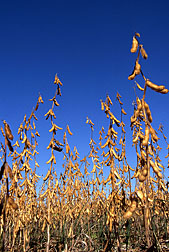Science Update
Presenting Prince, a New Blueberry Cultivar
ARS scientists have released a new early-ripening rabbiteye blueberry cultivar that can be grown with other blueberry varieties to extend the growing and harvesting season in the U.S. Gulf Coast region. The new variety, named “Prince,” was tested over several years and received high scores in several categories, including productivity, vigor, and fruit quality. The Mississippi climate—with occasional early-spring frosts and excessive heat and humidity—presents difficult challenges to blueberry growers. Prince tends to have an early but extended bloom period. Even though this allows it to overcome some injury from early-spring frost, some frost protection may still be required.
One of the most notable features of Prince is that it ripens 4 to 5 days sooner than other early-ripening rabbiteye blueberry varieties. This allows growers to capitalize on the lucrative early-season, fresh-blueberry market period. A cross between MS 598 and Florida 80-11, Prince blueberries are medium in size and color with a mild flavor and less tartness than many other rabbiteye varieties.
Stephen J. Stringer, Southern Horticultural Laboratory, Poplarville, Mississippi; phone (601) 403-8768.
|
|
Extreme Weather Boosts Antioxidant Levels in Soybean Seeds
New findings suggest that weather and climate play key roles in the antioxidant levels of soybeans. Tocopherols are a family of antioxidants that protect biological membranes. In this family, alpha-tocopherol is the active form of vitamin E in humans, and soybean seeds are a major source of dietary tocopherol. Researchers analyzed the content of tocopherols in soybean seeds grown at several locations in Maryland between 1999 and 2002.
Weather was relatively normal between 1999 and 2001, but conditions in 2002 included extreme drought and warmer temperatures. There were small but significant increases in the proportion of alpha-tocopherol in beans from the same genetic line grown in warmer, full-season Eastern Shore locations compared to beans that matured under slightly cooler conditions. But under the extreme drought conditions in 2002, early-maturing lines had as much as a 3.5-fold increase in relative alpha-tocopherol content, compared to the other years when rainfall was adequate. The studies highlighted how global climate change might affect the nutritional properties of food crops.
Steven J. Britz, Food Components and Health Laboratory, Beltsville, Maryland; phone (301) 504-6625, ext. 241.
Scientists Serve Up Mustard Meal To Tame Weeds
Studies suggest sinalbin degradation products and other compounds released into soil by applications of white mustard seed meals can kill or suppress certain weedy grasses and annual broadleaf weeds. Sinalbin is the same compound that gives white mustard its pungent flavor.
The effects of three mustard seed meals were evaluated at three application rates: half a ton, 1 ton, and 2 tons per acre. The 1-ton and 2-ton rates worked best in peppermint, reducing barnyard grass, green foxtail, common lambsquarters, henbit, and redroot pigweed populations by 90 percent several weeks after application. But regardless of the application rate used, the treatment severely damaged onion bulb crops when applied before emergence or before the onions produced two true leaves. Applications at the two-leaf stage or later were more promising. In trials with potted rose, phlox, coreopsis, and pasque flower, the treatment killed or reduced the growth of annual bluegrass, common chickweed, creeping woodsorrel, and liverwort.
Rick Boydston, Vegetable and Forage Crops Research Laboratory, Prosser, Washington; phone (509) 786-9267.
Military Uniforms Now Provide Reliable Protection From Mosquitoes
Since 1991, military uniforms have been treated with the insecticide permethrin to help protect troops from mosquitoes that transmit human disease pathogens. But unless the permethrin is applied correctly, its repellent action will be lost when the uniforms are washed. Researchers with the United States Marine Corps (USMC) focused on improving permethrin retention by changing the treatment process and using different chemical binders, but they needed a consistent way to assess the efficacy of these efforts in a range of fabrics and uniform types.
An ARS scientist developed a new insect-bite-protection efficacy assessment that requires evaluation of multiple uniform fabric specimens on four human volunteers and against two species of mosquitoes before the uniforms are accepted for production and distribution to military personnel. The precise results gained from this method will provide the military with information on how well the uniform protects and prevents deployed personnel from receiving insect bites. This methodology, which was adopted by the USMC, is now being used to evaluate U.S. Army and Air Force uniforms and is available for military uses only.
Ulrich R. Bernier, Mosquito and Fly Research Unit, Gainesville, Florida; phone (352) 374-5917.
"Science Update" was published in the August 2009 issue of Agricultural Research magazine.







